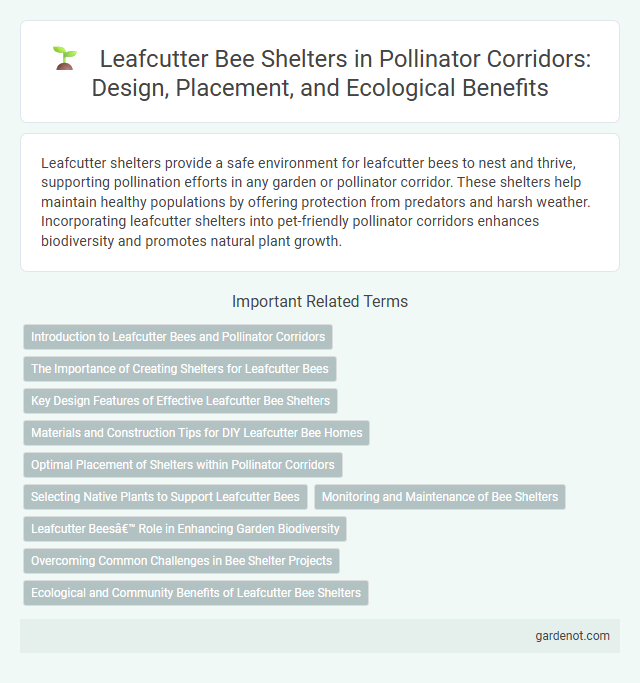Leafcutter shelters provide a safe environment for leafcutter bees to nest and thrive, supporting pollination efforts in any garden or pollinator corridor. These shelters help maintain healthy populations by offering protection from predators and harsh weather. Incorporating leafcutter shelters into pet-friendly pollinator corridors enhances biodiversity and promotes natural plant growth.
Introduction to Leafcutter Bees and Pollinator Corridors
Leafcutter bees are essential pollinators known for their unique behavior of cutting leaves to construct nests, playing a critical role in maintaining biodiversity within pollinator corridors. Pollinator corridors designed with leafcutter bee shelters provide safe nesting habitats that support their population growth and enhance pollination efficiency for native plants and crops. Integrating these shelters increases habitat connectivity and promotes ecosystem health by supporting diverse pollinator species.
The Importance of Creating Shelters for Leafcutter Bees
Creating shelters for leafcutter bees enhances their survival by providing safe spaces for nesting and protection from predators and harsh weather conditions. These shelters support pollination efficiency in local ecosystems, boosting the reproduction of numerous plants and crops. Establishing pollinator corridors that include leafcutter shelters promotes biodiversity and strengthens ecological resilience.
Key Design Features of Effective Leafcutter Bee Shelters
Effective leafcutter bee shelters incorporate segmented nesting tubes with smooth interior surfaces to facilitate uninterrupted leaf cutting and nesting activities. Durable, weather-resistant materials such as untreated wood or bamboo protect against environmental stress and predation, ensuring optimal shelter longevity. Strategic placement in sunny, sheltered locations with easy access to diverse floral resources supports the bees' foraging efficiency and population growth.
Materials and Construction Tips for DIY Leafcutter Bee Homes
Leafcutter bee homes are best constructed using untreated natural materials such as wood, bamboo, or hollow plant stems to mimic their native nesting environments. Ensure the shelter has properly sized tunnels, ideally between 4 to 8 mm in diameter, with smooth interiors to facilitate nesting and prevent damage to the bees' wings. Position the homes in warm, sunny locations sheltered from rain and strong winds to enhance occupancy and support leafcutter bee pollination activities in the corridor.
Optimal Placement of Shelters within Pollinator Corridors
Optimal placement of leafcutter bee shelters within pollinator corridors enhances nesting success and foraging efficiency by situating them near diverse floral resources and sheltered microhabitats. Positioning shelters in sunny, well-drained areas with minimal disturbance supports leafcutter bee population stability and biodiversity. Integrating these shelters at regular intervals along corridors increases connectivity and promotes effective pollination services across fragmented landscapes.
Selecting Native Plants to Support Leafcutter Bees
Selecting native plants such as lupine, coneflowers, and black-eyed Susans provides essential nectar and pollen for leafcutter bees, enhancing their habitat within pollinator corridors. These plants support the bees' foraging needs and improve leafcutter shelter success by encouraging nesting and reproductive behaviors. Incorporating diverse native flora ensures a continuous food supply throughout the leafcutter bee's active seasons, promoting population stability.
Monitoring and Maintenance of Bee Shelters
Regular monitoring of leafcutter bee shelters ensures optimal conditions for pollinator health by detecting signs of pest infestations or structural damage early. Maintenance activities include replacing worn nesting materials and cleaning shelter compartments to promote effective breeding and reduce disease risks. Implementing a consistent monitoring schedule supports stable leafcutter bee populations within pollinator corridors, enhancing biodiversity and crop pollination.
Leafcutter Bees’ Role in Enhancing Garden Biodiversity
Leafcutter bees play a crucial role in enhancing garden biodiversity by efficiently pollinating a wide variety of flowering plants, which supports ecosystem health and resilience. Providing dedicated leafcutter shelters offers safe nesting sites that encourage their population growth and sustained pollination activity. These shelters help maintain pollinator corridors, promoting genetic diversity and flourishing plant communities within urban and rural gardens.
Overcoming Common Challenges in Bee Shelter Projects
Leafcutter bee shelters often face challenges such as moisture retention, predator protection, and proper nesting materials, which can be mitigated by using water-resistant building materials, incorporating predator guards, and providing optimal substrates like hollow stems or bamboo tubes. Ensuring adequate airflow and shade helps prevent mold and overheating, improving the survivability of leafcutter bee populations within pollinator corridors. Consistent maintenance and monitoring are essential to address emerging issues promptly and support healthy bee shelter ecosystems.
Ecological and Community Benefits of Leafcutter Bee Shelters
Leafcutter bee shelters provide essential nesting habitats that support the ecological role of these pollinators in maintaining biodiversity and enhancing crop yields. By encouraging leafcutter bee populations, these shelters promote natural pollination processes critical for sustaining local ecosystems and agricultural productivity. Community involvement in building and maintaining leafcutter shelters fosters environmental awareness and strengthens conservation efforts within pollinator corridors.
Leafcutter shelter Infographic

 gardenot.com
gardenot.com